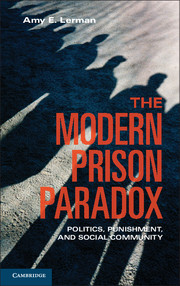Book contents
- Frontmatter
- Miscellaneous Frontmatter
- Contents
- Acknowledgments
- 1 The Modern Prison Paradox
- 2 Politics and the Punitive Turn
- 3 Public Policy and the Creation of Community
- 4 The Culture and Consequence of Prison
- 5 The Social Effects of Incarceration
- 6 The Social Effects of Prison Work
- 7 From Individuals to Communities
- 8 The Road to Reform
- 9 Epilogue (Or: How I Went to Berkeley and Wound Up in Prison)
- Appendixes
- Notes
- Index
2 - Politics and the Punitive Turn
Published online by Cambridge University Press: 05 June 2014
- Frontmatter
- Miscellaneous Frontmatter
- Contents
- Acknowledgments
- 1 The Modern Prison Paradox
- 2 Politics and the Punitive Turn
- 3 Public Policy and the Creation of Community
- 4 The Culture and Consequence of Prison
- 5 The Social Effects of Incarceration
- 6 The Social Effects of Prison Work
- 7 From Individuals to Communities
- 8 The Road to Reform
- 9 Epilogue (Or: How I Went to Berkeley and Wound Up in Prison)
- Appendixes
- Notes
- Index
Summary
The founders of a new colony, whatever Utopia of human virtue and happiness they might originally project, have invariably recognized it among their earliest practical necessities to allot a portion of the virgin soil as a cemetery, and another portion as the site of a prison.
Nathaniel Hawthorne, The Scarlet Letter (1850)Over the past half-century, the United States has vastly expanded its powers to punish, rapidly increasing institutional capacity, public expenditures, and personnel devoted to this task. The most obvious reflection of these changing trends in governance is the nation’s rising rate of incarceration. During the latter half of the 20th century, the prison admission rate skyrocketed. In 1960, there were roughly 330,000 prison and jail inmates in America; there were almost 2.3 million by 2010.
Scholars have long argued that this precipitous growth in the correctional population was not purely a functional response to changes in the crime rate, however. In fact, rates of violent crime in the period from 1960 to 2004 increased most precipitously during the 1960s and 1970s, rising about 125 percent. The same is true of property crime, which increased roughly 100 percent from 1960 to 1969. In contrast, the number of adults under correctional jurisdiction remained relatively stable until the mid-1970s, and only then did it begin to rise. This growth subsequently continued during the mid-1990s and beyond. Even as crime rates began to fall, prison admissions continued to climb (see Figure 2.1).
- Type
- Chapter
- Information
- The Modern Prison ParadoxPolitics, Punishment, and Social Community, pp. 24 - 43Publisher: Cambridge University PressPrint publication year: 2013



